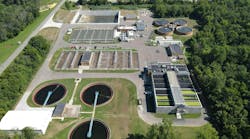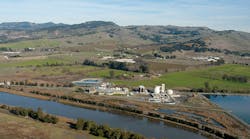Located along the eastern coast of Lake Michigan at the mouth of the Grand River, Grand Haven, Mich., is the seat of Ottawa County and has a population of more than 10,000 residents. Officially recognized as “Coast Guard City, USA,” it has been home to a number of historic U.S. Coast Guard events, and welcomes more than 300,000 visitors for its annual Coast Guard Festival held on the lake.
Grand Haven’s original water filtration plant was built in 1927, taking advantage of prefiltration practices by utilizing near-shore wells that were implemented before the plant was built. Increasing population made it difficult for the plant to keep up with the demand, so in 1975, Ottawa County and the surrounding communities regionalized the water purification system, creating the Northwest Ottawa Water System. Today, the plant is owned by the county and operated by the city of Grand Haven.
Evolving Infrastructure
Through county municipal bonds, the city was able to fund a new facility in the mid-1980s. Completed in 1986, Michigan’s first direct filtration facility had an original capacity of 12 million gal per day (mgd), which eventually was increased to 15.5 mgd.
In 2012, the facility underwent a major upgrade, adding 16,000 sq ft of new plant space and switching the process from dual filter media to 52 in. of anthracite—now a deep-bed mono-media direct filtration system. During this upgrade, additional flocculation was added, as well as a new residual dewatering system and filter backwash wastewater clarifier. Three existing low-service pumps were replaced with variable frequency drive pumps. More than 1,000 ft of new 30-in. raw water transmission main were added to complement the existing main to the treatment plant.
The plant currently has a capacity of 23.25 mgd, and can filter 6.63 gal per minute per sq ft in each of its eight deep-bed mono-media filters. The plant’s infrastructure includes infiltration beds; a pump station; high- and low-service pumps that include vertical turbine pumps and variable frequency drives; butterfly valves and operators; rapid, lightning and flocculation mixers; clarification equipment; chemical metering pumps; chemical transfer pumps; fiberglass-reinforced plastic tanks; gravity and dewatering filters; boilers; a dehumidification system; air conditioning and air handlers; and a SCADA system.
Leveraging the Lake
“The most unique portion of this process and infrastructure is our buried intakes located near the shore in Lake Michigan,” said Joseph VanderStel, water facilities manager for the Northwest Ottawa Water Treatment Plant. “Two infiltration beds are used to withdraw raw water through approximately 14 ft of sand [and] deliver prefiltered water to the filtration plant.”
Each 260-by-240-ft intake structure is made of ductile iron and PVC piping and is layered with 17A coarse filter sand and 2NS fine filter sand, and is capped with natural beach sand. Each intake can supply 14 mgd.
The intakes undergo scheduled maintenance at specified intervals throughout the summer to ensure the plant keeps up with demand. The maintenance routine consists of low-flow backwashing and utilizing a marine contractor to drag a 20-ft I-beam across the bottom of the lake within the area of each intake.
“This is needed, as the city of Grand Haven sits at the mouth of the Grand River, the largest tributary in the state of Michigan,” VanderStel said. “The river empties near the intakes into Lake Michigan, producing a sediment plume that can cause some restrictive flow in drawing water from the intakes. As the silt and colloidal material settle on top of the intakes, it creates a thick layer of material that at times restricts pumpage of water from the lake.”
Although this restricted flow has happened in the past, VanderStel said the maintenance program has nearly eliminated this outcome.
The proximity to the lake poses some additional challenges for the plant. Suspended material in lake currents has been known to increase turbidity, and fine silt and organics can disturb the plant’s filtration efficiency. The demand from increased summer tourist traffic also can place stress on the system.
The plant is considering sustainable technologies, such as high-efficiency lighting fixture replacements and solar energy. Plans are also in the works for pretreatment ultraviolet disinfection and a water information management and computerized maintenance management system.
Download: Here


